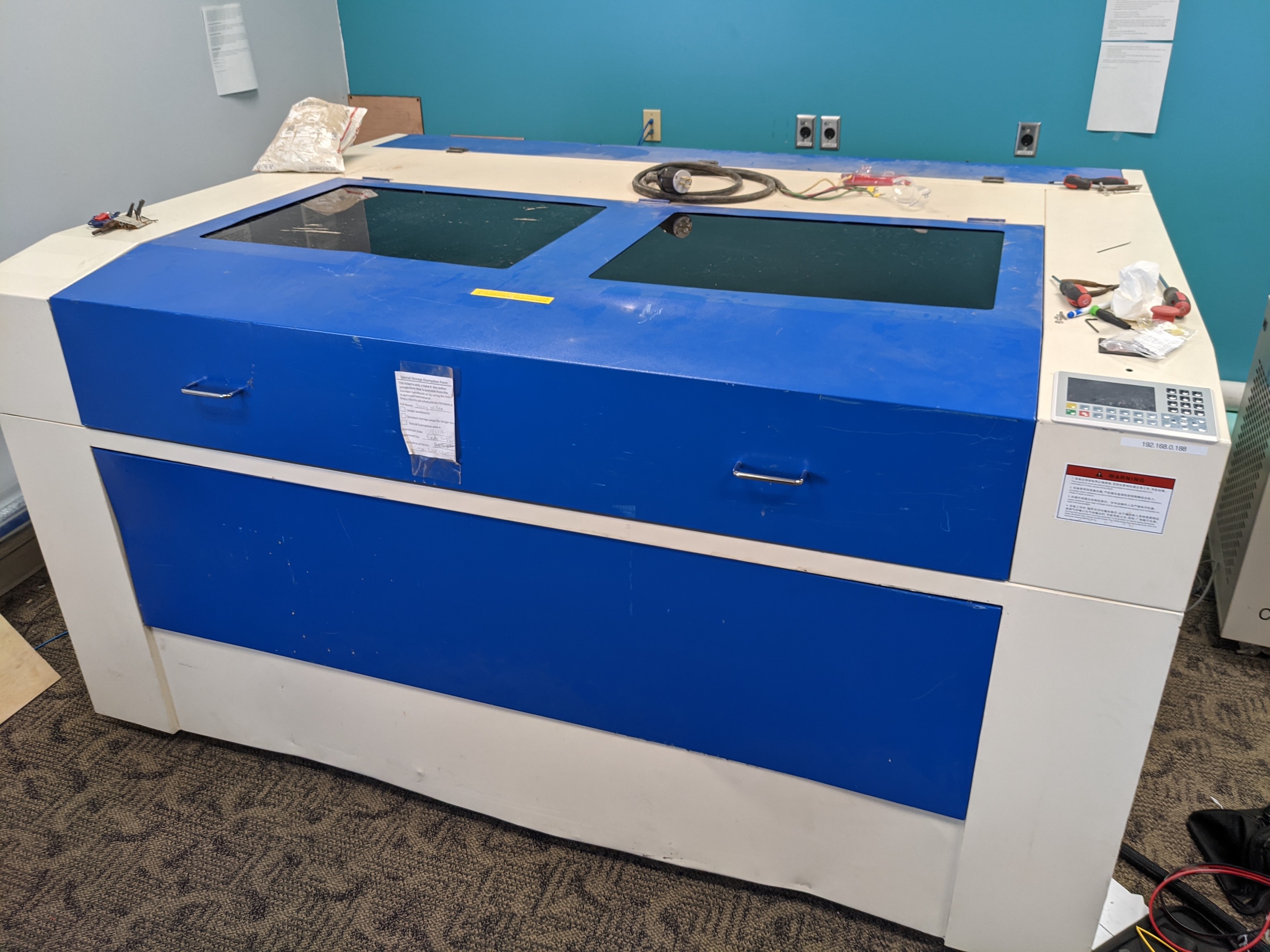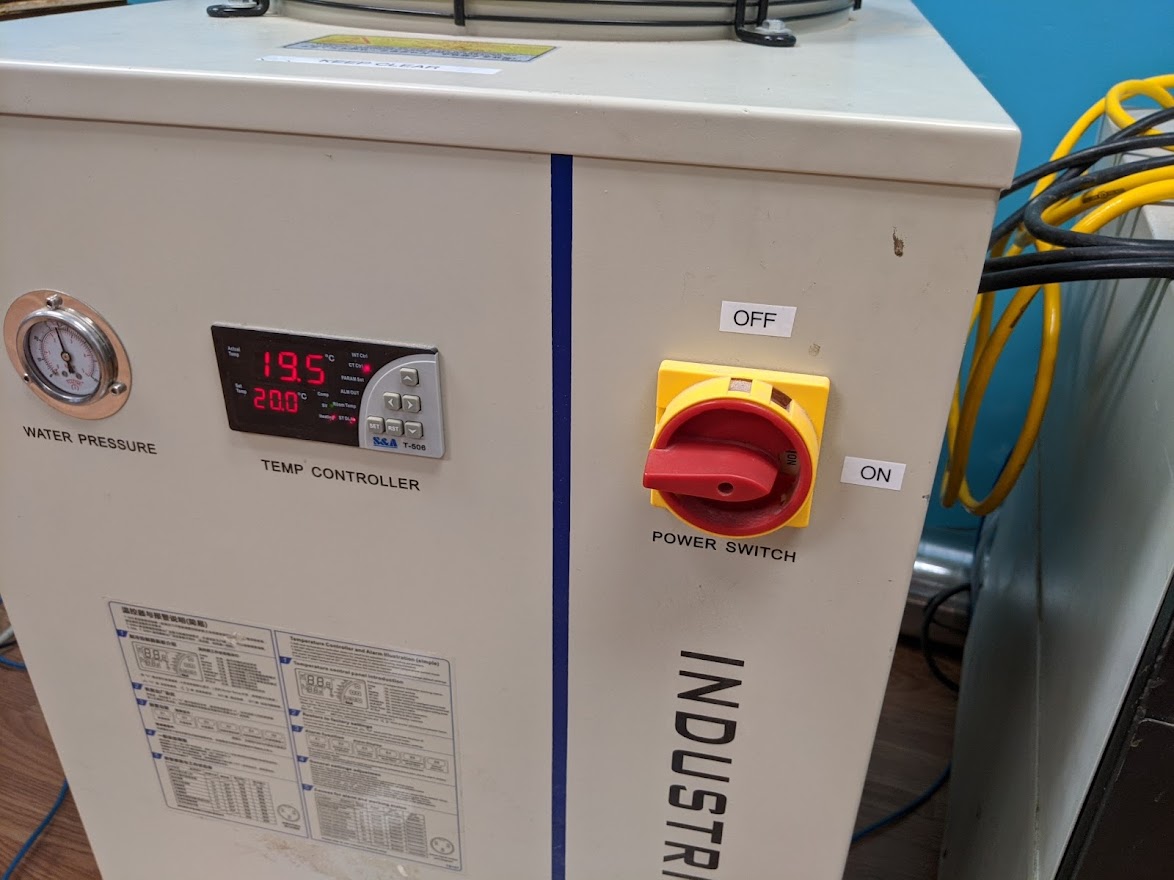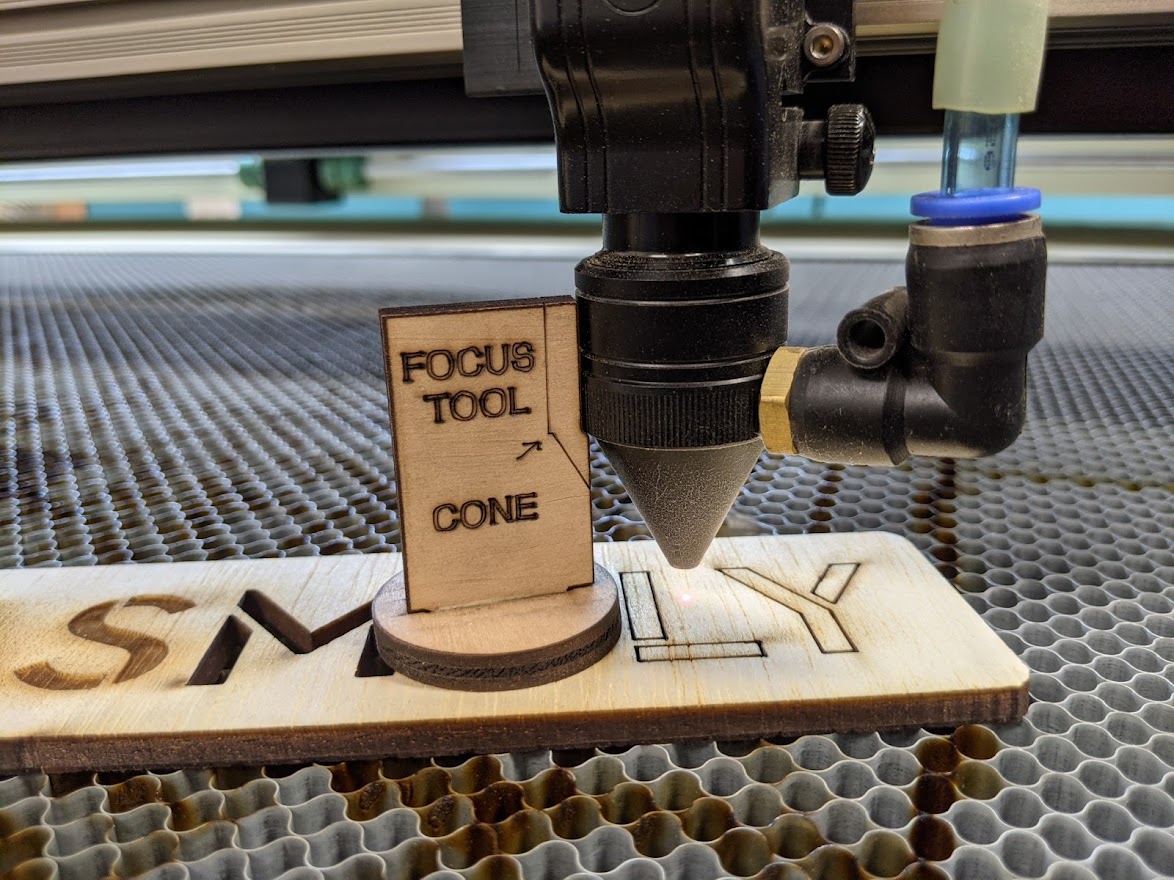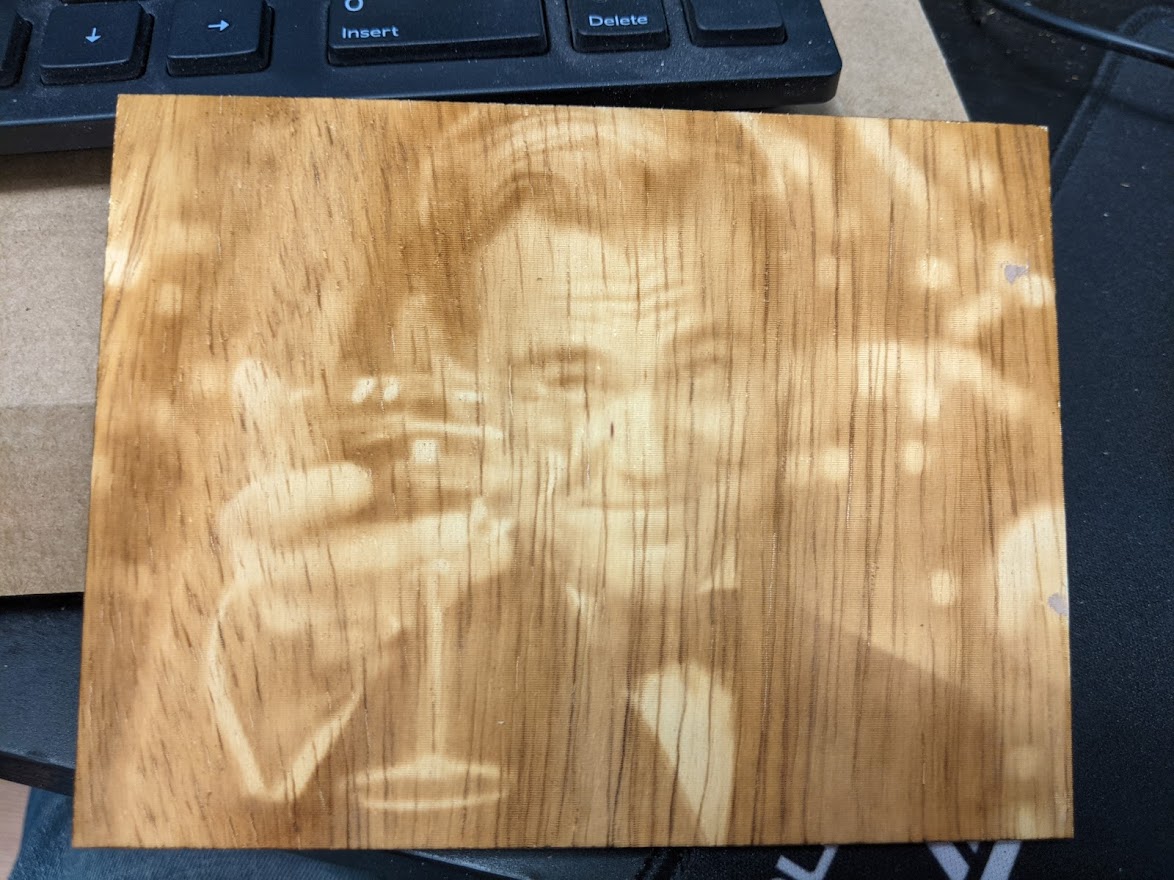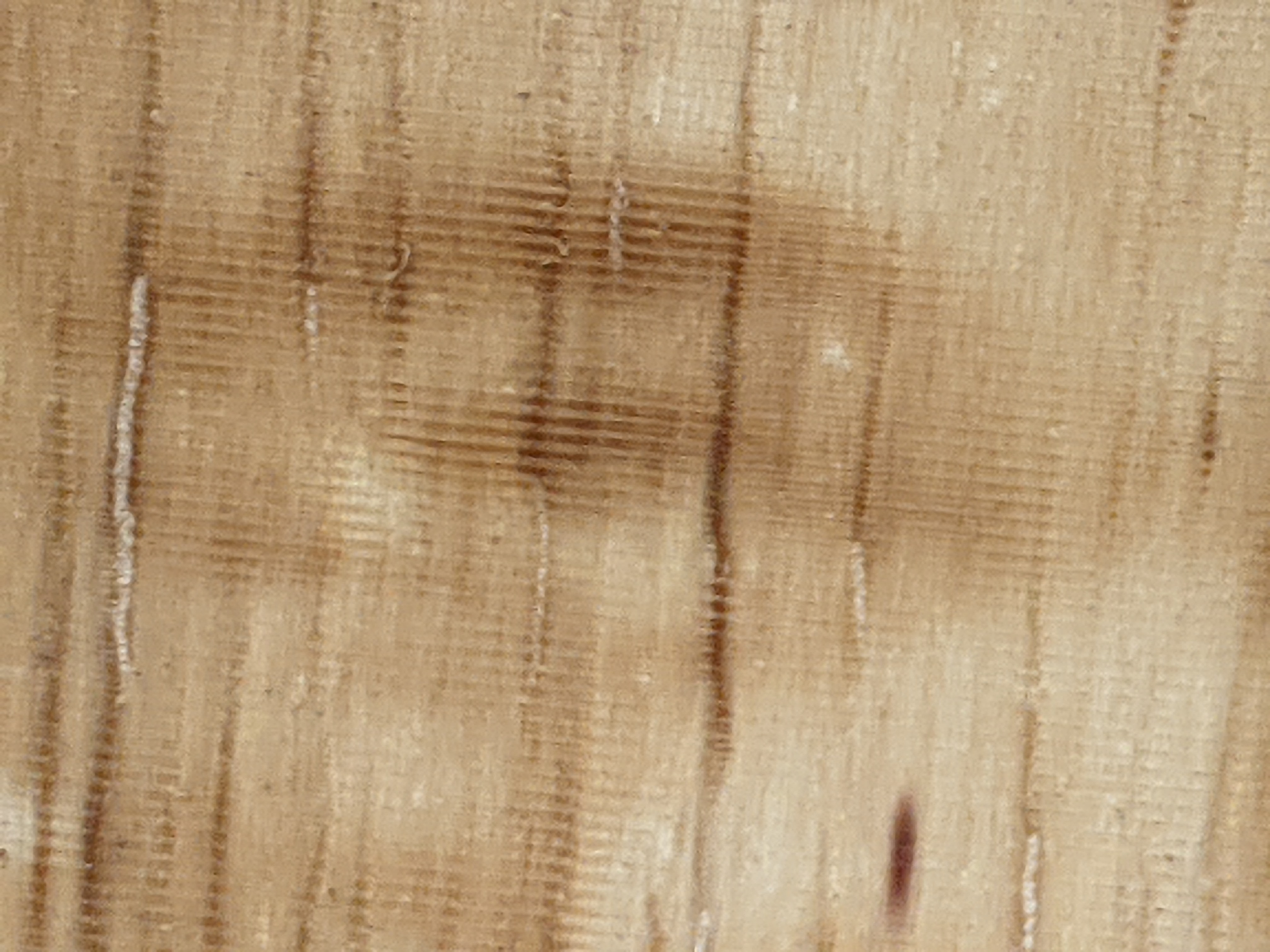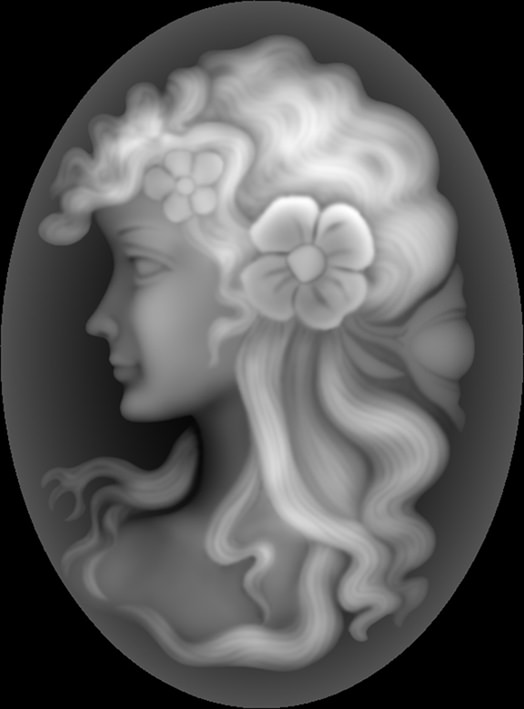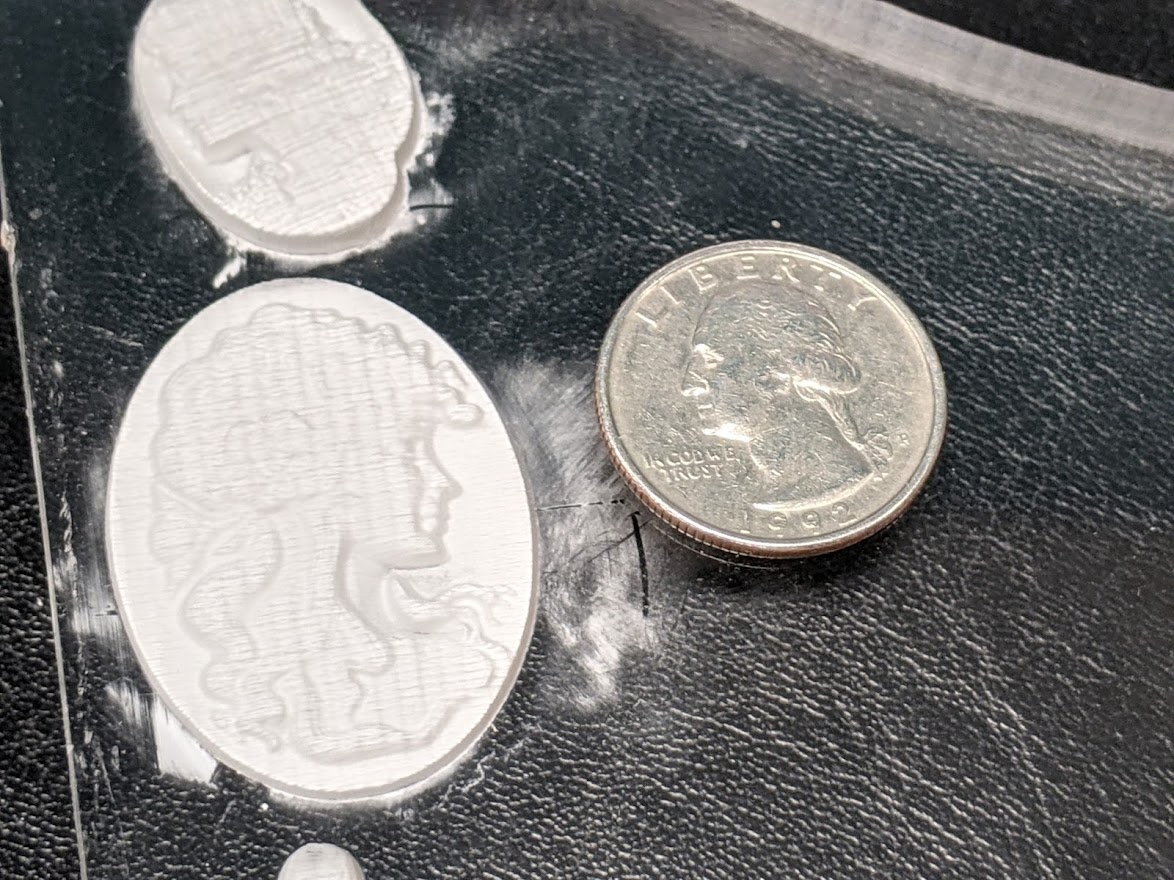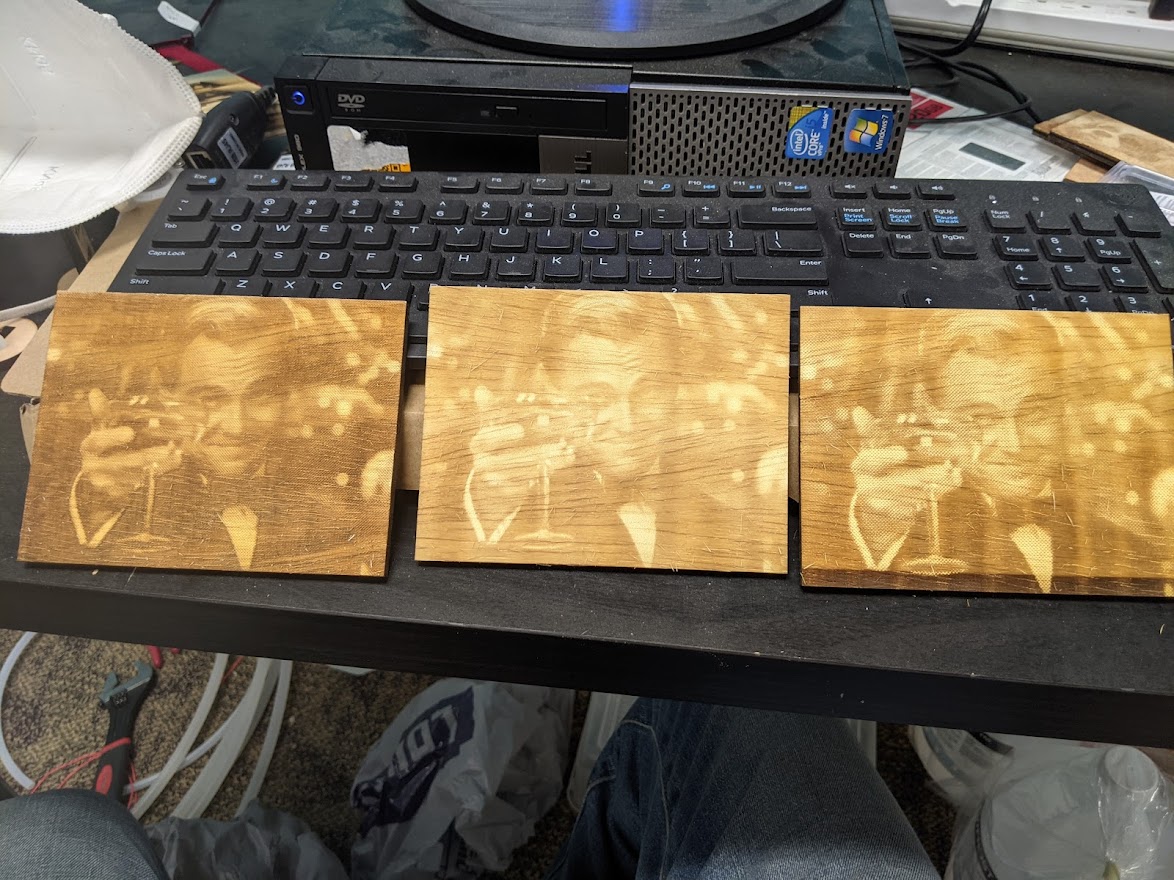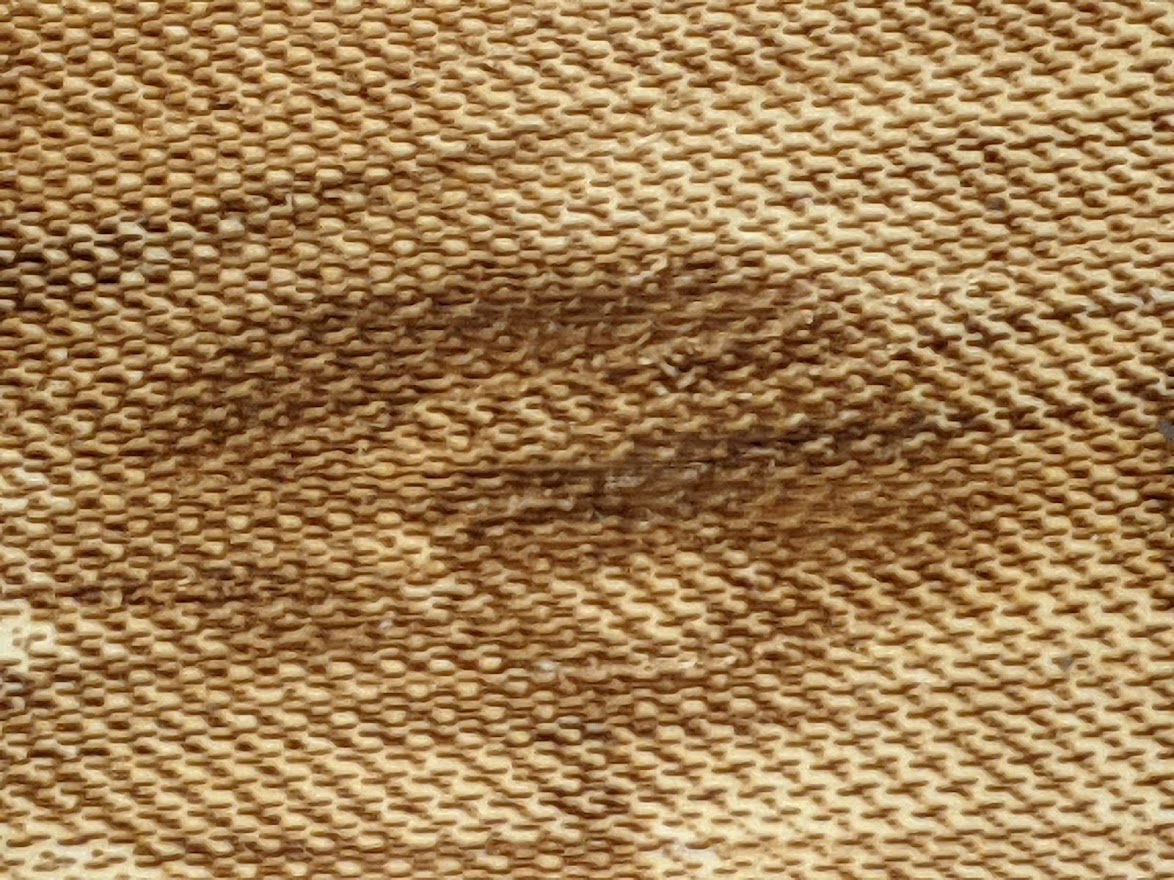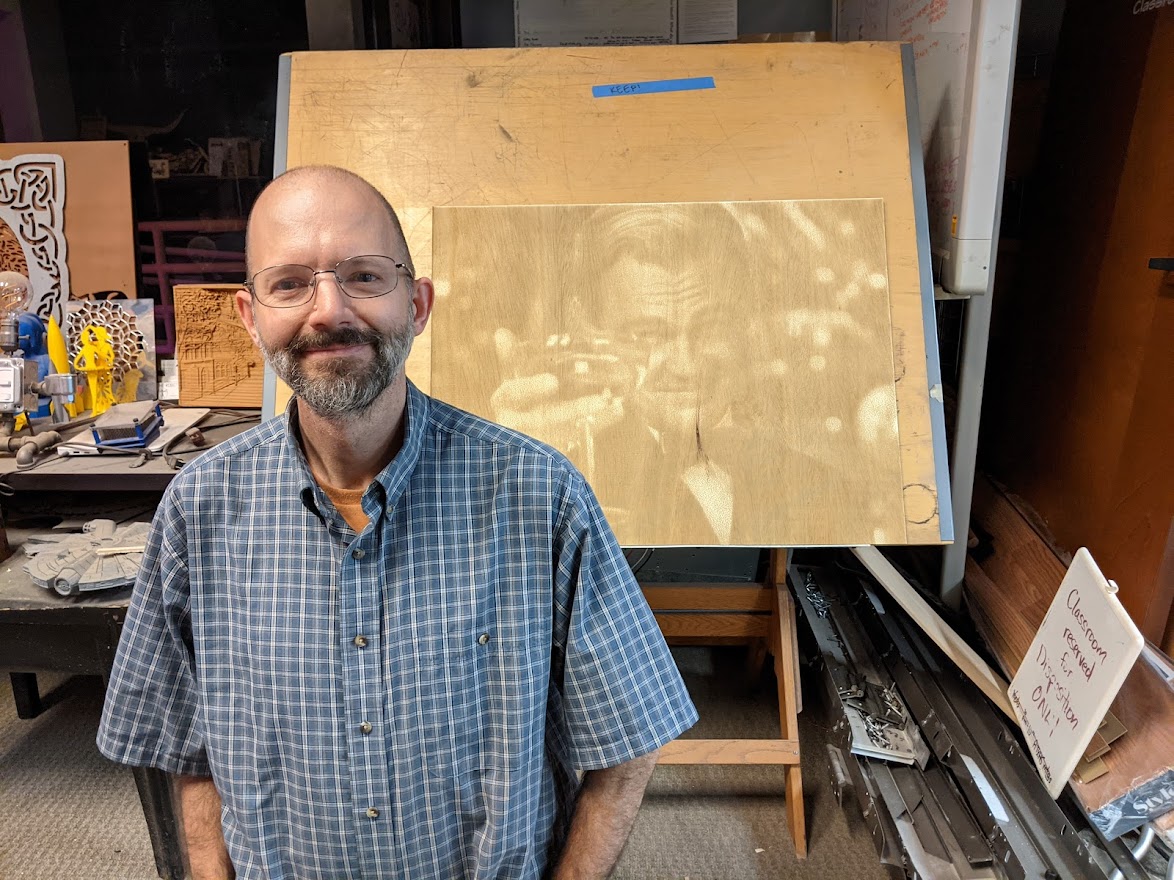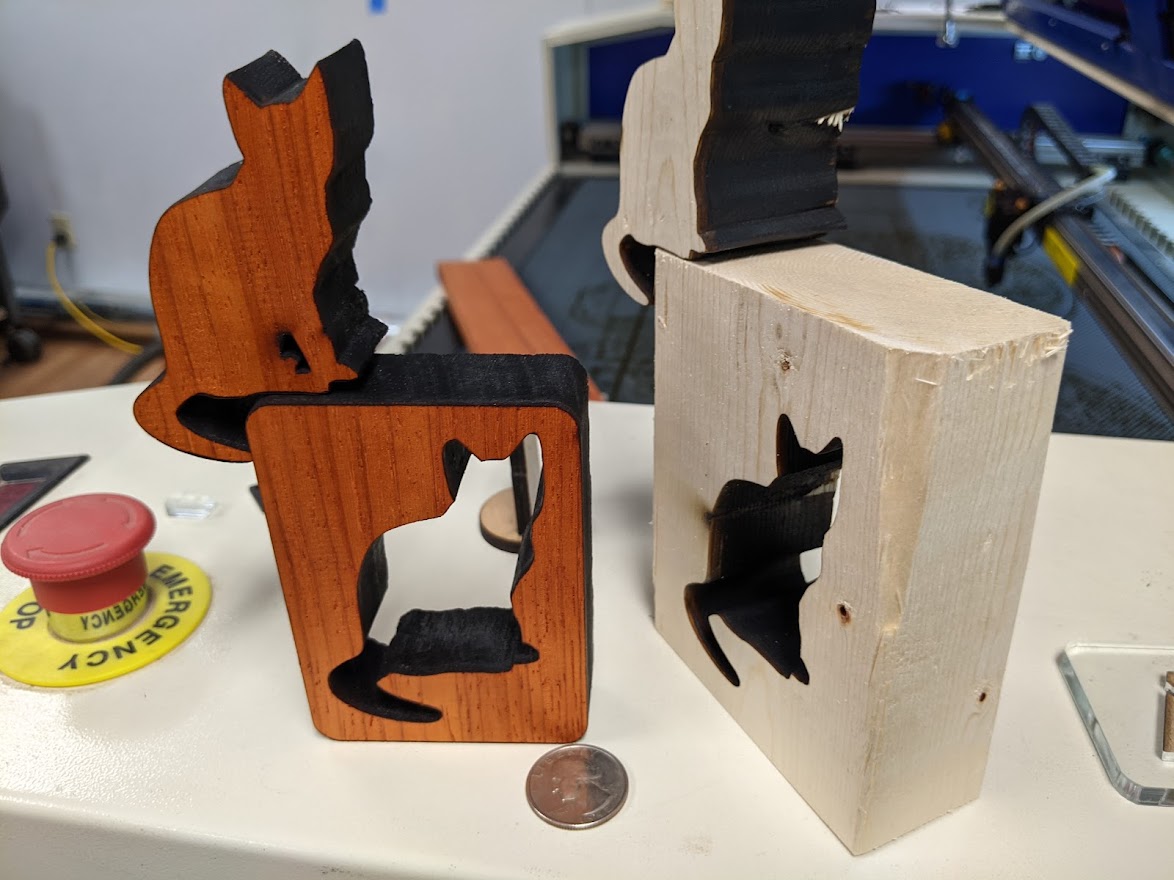Difference between revisions of "Tarkin"
| Line 99: | Line 99: | ||
== Power Settings (in Lightburn layers) == | == Power Settings (in Lightburn layers) == | ||
| − | Lightburn has a database of known-good values for cutting and rastering on Tarkin, listed by material. Feel free to use them, but these can only be created or modified by admin. If you want a new entry, please submit the parameters and if possible a piece of that material and we can include it. Pearl will also have a Lightburn material database after it is converted to that controller, but it will have different values as the beam's power is different. | + | Lightburn has a sizable and growing database of known-good values for cutting and rastering on Tarkin, listed by material. Feel free to use them, but these can only be created or modified by admin. If you want a new entry, please submit the parameters and if possible a piece of that material and we can include it. Pearl will also have a Lightburn material database after it is converted to that controller, but it will have different values as the beam's power is different. |
| + | |||
| + | In general, if you have a material which is not listed exactly, scale speed and/or power proportionally. | ||
| + | |||
| + | e.g. if you only had a setting for cutting 6mm acrylic but you have 8mm, you need about 8/6= 1.333x the "burn" per mm. First off, if the power is not 100%, scale up the power- however, for most cutting we already max out the power and increase speed to the max that will still cut cleanly through the material. So the existing setting might be 6mm acrylic, 100% power, 35 mm/sec. In general you would scale proportionately- 35 mm/sec for the thin, fast 6mm divided by 1.333x gets us 26mm/sec on the thicker, slower 8mm. | ||
The machine's top axis speed is set well over 1000 mm/sec, but this is not likely to be important for rastering as this sort of speed is not commonly used. If the user's job asks for a speed higher than the machine can travel, the machine will limit its speed and proportionately scale back the % power to deliver the same energy per mm of length. | The machine's top axis speed is set well over 1000 mm/sec, but this is not likely to be important for rastering as this sort of speed is not commonly used. If the user's job asks for a speed higher than the machine can travel, the machine will limit its speed and proportionately scale back the % power to deliver the same energy per mm of length. | ||
| Line 129: | Line 133: | ||
A bitmap used for this purpose is called a "depth map", but it is essentially a grayscale image with depth represented as darker pixels. But this is still fundamentally different from a picture- if a photograph of a light-skinned person were cut as a depth map, it would appear grossly distorted- the whites of the eyes are highest, the hair would be cut deep, and pupils cut deepest. | A bitmap used for this purpose is called a "depth map", but it is essentially a grayscale image with depth represented as darker pixels. But this is still fundamentally different from a picture- if a photograph of a light-skinned person were cut as a depth map, it would appear grossly distorted- the whites of the eyes are highest, the hair would be cut deep, and pupils cut deepest. | ||
| − | [[File:Depth Map.jpg|thumb|Depth Map]] | + | [[File:Depth Map.jpg|thumb|Depth Map|alt=|left]][[File:PXL 20211121 010329469.jpg|thumb|Cut depth map, negative image cut from rear in acrylic|alt=|center]]If you want to avoid creating obvious unburned areas where the shading is very light, set MIN POWER parameter >0%. While in the raster area, this rescales the laser output. Black is MAX POWER %, white is MIN POWER %. In acrylic we often allow the lightest shading to remain untouched clear acrylic for contrast. |
| − | |||
| − | If you want to avoid creating obvious unburned areas where the shading is very light, set MIN POWER parameter >0%. While in the raster area, this rescales the laser output. Black is MAX POWER %, white is MIN POWER %. In acrylic we often allow the lightest shading to remain untouched clear acrylic for contrast. | ||
3D may utilize smaller line intervals effectively, it will just burn deeper as lines overlap. However, in general increasing the power may be more practical. | 3D may utilize smaller line intervals effectively, it will just burn deeper as lines overlap. However, in general increasing the power may be more practical. | ||
| Line 141: | Line 143: | ||
3D reliefs have difficulty scaling. 15mm acrylic cut a max depth of 8mm might produce a great quality image when rendered in a 100mm x 100mm frame. However, when increased to 200mm x 200mm, the same 15mm acrylic cannot be burned twice as deep. If burned to the same depth, the image will be relatively flat in the Z dimension. In order to maintain the original scale, the acrylic stock would need to be 30mm thick! | 3D reliefs have difficulty scaling. 15mm acrylic cut a max depth of 8mm might produce a great quality image when rendered in a 100mm x 100mm frame. However, when increased to 200mm x 200mm, the same 15mm acrylic cannot be burned twice as deep. If burned to the same depth, the image will be relatively flat in the Z dimension. In order to maintain the original scale, the acrylic stock would need to be 30mm thick! | ||
| − | Reliefs in clear acrylic look MUCH better when mirrored, the shading | + | Reliefs in clear acrylic look MUCH better when mirrored, the shading changed to "negative image", and cut from the BACK side. When edge lit, the look is fantastic! |
| − | + | ==== DITHER/HALFTONING 2D ==== | |
| + | Works well with material with a poor dynamic range. Image is made of burned and unburned spots. The size of the burned spots increases with darker shade, but darker does NOT make the beam stronger. A wide range of methods are available that arrange burned vs unburned regions. | ||
| − | + | Dithering/halftoning MUST use correct Line Interval that matches the beam width. | |
| − | |||
| − | + | ===== Standard Focus ===== | |
| + | The width of the beam at good focus is approximately 0.15mm. Line intervals >0.2mm will create parallel lines rather than a solid fill. | ||
If you are doing photographic raster work such as dithering/halftoning, line intervals <0.125mm will distort the image shading. The scheme of dithering is we have the original unburned surface and burned "brown" areas and nothing in between. The appearance of "shading" is created by a ratio of these, not by turning the laser intensity up and down. When Line Interval is <0.125mm, raster lines overlap significantly and combine their burned areas, and the area that was intended to be bright and unburned on one line may actually be made brown by the line(s) above and below it, and the image will have distorted shading or even lost entirely in a mass of brown. | If you are doing photographic raster work such as dithering/halftoning, line intervals <0.125mm will distort the image shading. The scheme of dithering is we have the original unburned surface and burned "brown" areas and nothing in between. The appearance of "shading" is created by a ratio of these, not by turning the laser intensity up and down. When Line Interval is <0.125mm, raster lines overlap significantly and combine their burned areas, and the area that was intended to be bright and unburned on one line may actually be made brown by the line(s) above and below it, and the image will have distorted shading or even lost entirely in a mass of brown. | ||
[[File:PXL 20211110 035206778.jpg|thumb|DiCaprio in halftoning, line interval 0.150mm]] | [[File:PXL 20211110 035206778.jpg|thumb|DiCaprio in halftoning, line interval 0.150mm]] | ||
[[File:PXL 20211120 053808481.jpg|center|thumb|Closeup of DiCaprio's eye in Halftoning, line interval 0.150mm]] | [[File:PXL 20211120 053808481.jpg|center|thumb|Closeup of DiCaprio's eye in Halftoning, line interval 0.150mm]] | ||
| + | |||
| + | ===== Halftoning/Dithering with +Focus ===== | ||
| + | Large rasters benefit greatly from running out of focus to enlarge the spot size. | ||
| + | |||
| + | Running the Z lower will widen the spot in a predictable, consistent way. +14mm will yield a 1mm spot size. Start by focusing for the top as usual using the tool, note the value of "Z" on the panel, it should be around 3000mm, but this is only used as relative value. Write down the number for the focal point and add 14mm to it- e.g., if the panel reads 2998.2mm after setting Z with the focus tool, you would jog down to 2998.2 + 14 = 3012.2. | ||
| + | |||
| + | The spot is widened to 1mm at this point. The Line Interval will be set to 1mm. Since the beam is spread over a larger area, it will be able to use all the power without blasting through the wood. 100% power 1000mm/s 1mm Line Interval and Jarvis dithering yields this. Despite its massive size, 839mm x 644mm, it was done in just over 12min. | ||
| + | [[File:PXL 20211122 044306653.jpg|center|thumb|Giant raster based on 1mm spot size]] | ||
=== RASTER EXTEND SPACE: what's that? === | === RASTER EXTEND SPACE: what's that? === | ||
| Line 183: | Line 194: | ||
Tarkin cuts lumber up to 1.5" thick (actual dimension), very successfully. The edges are very clean and straight | Tarkin cuts lumber up to 1.5" thick (actual dimension), very successfully. The edges are very clean and straight | ||
| + | [[File:Lumber cats.jpg|center|thumb]] | ||
1/2" black acrylic has cut very well. Thicker may be possible. | 1/2" black acrylic has cut very well. Thicker may be possible. | ||
| Line 211: | Line 223: | ||
=== SYS ALARM, MACHINE PROTECTED === | === SYS ALARM, MACHINE PROTECTED === | ||
| − | + | Likely causes: | |
| + | |||
| + | # Door is open - just close the door | ||
| + | # Chiller is in Alarm state (not turned on, temp out of range, chiller detects no-flow). | ||
| + | # Head crash or excess raster speed has tripped a fault in the drive. Ensure the head is unobstructed and cycle main power | ||
=== FRAME SLOP === | === FRAME SLOP === | ||
| − | The job sent, with the current user origin, would go outside the bounds of the machine bed | + | The job sent, with the current user origin, would go outside the bounds of the machine bed. Move the user origin. |
=== NOT ENOUGH EXTEND SPACE === | === NOT ENOUGH EXTEND SPACE === | ||
| − | The raster's extend space will go outside the bounds of the machine bed, even if the raster art does not. | + | The raster's extend space will go outside the bounds of the machine bed, even if the raster art does not. Move the raster or reduce the rastering speed. |
== Current Quirks == | == Current Quirks == | ||
Revision as of 00:43, 23 November 2021
Tarkin is the new large-format laser cutter in the space. It's a custom-built laser cutter based on an RF CO2 10.6um laser and CCM linear rail motion system with a Ruida RDC6445G controller running Lightburn software. It features 225W of power on a 1.6M x 1.0 M (63"x39") cutting bed, powered Z, 8MB alignment camera, and air assist.
It's quite large and capable -- we don't think there's anything like it in central Texas.
Use as per https://wiki.asmbly.org/index.php/Covid_Policies#Equipment-specific_time_limits
A new class will be required for users. The Ruida controller utilizes a workflow that will be common among Asmbly lasers.
Setup
1. Locate Fire Extinguisher
Please locate the 2 HALOTRON fire extinguishers as you enter the laser room. These are the preferred extinguishers as Halon is a clean smothering gas that leaves no residue. The other extinguishers outside the laser room are ABC, which smother by spraying a great deal of baking soda powder that is difficult to clean out of the laser. These may still be used in an emergency, but the HALOTRON extinguishers should be tried first.
2. Main Power Switch
Powers on laser. Currently also powers on exhaust fan and air assist pumps, however, these may soon be moved to a different switch so they do not need to be left on all the time. If so, an interlock will prevent the machine from running if they are not also activated at that time.
The lowest switch operates an LED light bar inside the bed
3. Chiller switch
Starts chiller, required for all work. The machine will refuse to run and give a "WATER PROT" error if the chiller is not pumping.
4. Locate E-STOP button
Backup safety feature, cuts power to Ruida, motor drives, and disables laser power supplies. The regular STOP button is preferred.
Once E-STOP is tripped, it will mechanically latch down and must be twisted 90 deg clockwise to allow it to release
The E-Stop button does NOT remove all power from the chassis. The chassis will be partially live unless all 3 plugs are unplugged from the wall
5. NEVER leave the laser while running
Important Terms
(just proposed for now, following documentation needs editing to use these consistently)
Machine bed
the physical machine's actual work area.
Control Panel
the Ruida hardware panel on the physical machine. Small color LCD and membrane keys. Not to be confused with the Lightburn software.
Material
your physical stock- a piece of plywood, acrylic sheet, etc. You'll be placing it on the machine bed and cutting your job on it.
Lightburn
the software on the PC for CAD, specifying what to cut and how, and has control for some live interaction with the machine. Your job is created within a workspace inside Lightburn.
Workspace
Lightburn's work area on the PC. This is the same as the machine bed only if you make the workspace size the same as machine bed size and operate in absolute coordinates. Otherwise, where your job is placed on the workspace is not necessarily where the job will be when you go to the machine bed, and your workspace can be declared in a different size than the machine bed. Note that in either case, your job (the actual content) will probably be smaller than the whole declared workspace, and cannot be located outside the workspace when you actually want to send it to the laser.
Job
your content- vector/raster operations you want the laser to do. The location of the job on the machine bed is flexible and can be moved from the control panel, or it can be fixed. Your job exists in two forms- on the workspace (Lightburn software), and on the machine bed (physical machine). In the case of user origin, they may not be in the same place.
User origin
your job's origin. It is not used in absolute coordinate operation. The user origin also has two forms- it is represented on the workspace with a green square, and can move in relation to your job. At the control panel, you will set the user origin to the current head position with the ORIGIN button, which moves your job so that the green square will be at that point.
Vector Cutting
The most common operation, the goal is to cut out your shapes
Vector Engraving
The goal is to mark the surface with a vector, but not cut all the way through. Amount of burn per inch is limited by raising Speed and/or reducing Power to avoid cutting through
Rastering
The goal is to mark the surface, or produce a 3D depth carving. The head will move back and forth many times, and step over via Line Interval each pass.
Rasters may begin as a form of bitmap graphic, or a solid Fill of any closed shape
Focusing
Focusing is currently done manually (this may change). For reference, the focal point is 6mm from the tip of the cone.
Although the head has an adjustable tube, we do not operate by adjusting the tube. Please ensure to tube is all the way up before continuing.
Place your material on the machine bed
jog the head above the material
Place focus tool on top of material as shown
Use the Z+/Z- keys to raise and lower the bed until the focus tool corner, as shown on the tool, aligns where the corner of the conical part of the cone turns into the cylindrical part.
Once you reach the proper height, nothing else needs to be pressed and you can continue to use the machine. The control panel will read out around "Z 3000mm". This number is not important. In cases where you need to deal with thick material, you may raise the bed from this point by as much as -5mm. If so, this readout can be used to measure simply by relative values. e.g. "Z 3002.7" after using focus tool. To achieve focus -2, press Z UP until the display reads "Z 3000.7"
Quirk: The machine bed can shift laterally by several millimeters in the X and Y, when Z is moved. Please adjust the Z BEFORE making any precision placement of origin. Until this is fixed, the Z should not be moved to different places within a job as the XY alignment may shift.
Origins
Tarkin's origin is commonly set in one of three ways:
Absolute coords
using a workspace the size of the machine bed. The location of your job is fixed and the user does not operate the ORIGIN button on the panel, as there is no user origin. The camera may or may not be activated
User origin
Your material is placed anywhere on the bed that is convenient, and the user moves the head to the desired origin point and presses "ORIGIN" to work around that spot. In this case, it is not important where the user places their job on the PC's workspace, or that the workspace be of the size of the laser's bed at all. Lightburn will automatically create a bounding box around all the user's job within the workspace, whether or not it is designated to be sent at that time. The user can specify the work origin to be in the center, any of the 4 corners (top left most common), or 4 sides (uncommon). It is possible to place the origin in a way that the job will eventually run off the machine bed, this will result in "FRAME SLOP ERROR" and will not run. Correct the origin position and use the FRAME button to verify its bounding box. Note that moving your job around the machine bed via the user ORIGIN button does not move your job on the workspace.
User Origin, CENTER, is the safest option if you are using clamps. The head will return to that origin at the end. So, that origin point being in the center of your job, no clamps should be in the way. However, the head will of course have to travel in a line from wherever it is to the start point, so if the user origin was not set correctly or the head is for some reason located outside the job before starting, it might still be possible to strike a clamp. Currently we do not think head strikes will be a big problem for the machine, mostly it would mean your material gets knocked around and your job could be spoiled.
Camera-placed absolute coords
Your material can be placed anywhere visible to the alignment camera, the Lightburn workspace is set to the full machine bed size, the user jogs the gantry out of the line of sight (not obscuring your material), and then Lightburn takes a camera snapshot of the machine bed that shows up as a graphical background with your material on the workspace. The very rear of the machine bed is not visible to the camera for alignment purposes, as the lid is hinged closer than that. The user moves and aligns the vectors/raster job across the workspace so it is over the actual material by moving the job in XY and, if necessary, rotation and resizing may also be done. Lightburn will automatically change to absolute coordinates in camera mode, and the user does not operate the ORIGIN button. This method can also be used for hybrid work- for example, color printing paper graphics that were glued to plywood earlier, this material is then placed and aligned via camera and cut out into desired shapes with the laser, or an existing manufactured object is placed on the bed and the job aligned over it. There is no auto-recognition of printed registration marks, but printed registration marks do make alignment easier and more accurate. Another example might be a unique horizontal slice of a tree can be traced and artwork can flow with that arbitrary shape in size and alignment. So far, the accuracy has been better than 2mm, and may be improved with further calibration.
Power Settings (in Lightburn layers)
Lightburn has a sizable and growing database of known-good values for cutting and rastering on Tarkin, listed by material. Feel free to use them, but these can only be created or modified by admin. If you want a new entry, please submit the parameters and if possible a piece of that material and we can include it. Pearl will also have a Lightburn material database after it is converted to that controller, but it will have different values as the beam's power is different.
In general, if you have a material which is not listed exactly, scale speed and/or power proportionally.
e.g. if you only had a setting for cutting 6mm acrylic but you have 8mm, you need about 8/6= 1.333x the "burn" per mm. First off, if the power is not 100%, scale up the power- however, for most cutting we already max out the power and increase speed to the max that will still cut cleanly through the material. So the existing setting might be 6mm acrylic, 100% power, 35 mm/sec. In general you would scale proportionately- 35 mm/sec for the thin, fast 6mm divided by 1.333x gets us 26mm/sec on the thicker, slower 8mm.
The machine's top axis speed is set well over 1000 mm/sec, but this is not likely to be important for rastering as this sort of speed is not commonly used. If the user's job asks for a speed higher than the machine can travel, the machine will limit its speed and proportionately scale back the % power to deliver the same energy per mm of length.
In general, Tarkin should be used to cut at 100% power. The amount of burn per inch is controlled by increasing the Speed parameter to the fastest travel that still consistently cuts through the material.
In cases of very light cutting (paper), vector engraving, or rastering, it is necessary to reduce power from 100% since it will cut all the way through the material even with very high Speed.
To test new material, the simplest thing is a line 20mm or longer. Less than 20mm may not get into constant-velocity mode and does not accurately represent the primary cutting ability.
Multiple passes are NOT useful
Rastering
Types of Rastering:
FILL
just marking/carving out even blocks. Line intervals <0.15mm cut deeper (typically not of value, just slows down job)
GRAYSCALE 2D
laser power is modulated by grayscale shade. Goal is not depth, but shading. Line intervals <0.15mm cut deeper (typically not of value, just slows down job). Grayscale works if your material can show good dynamic range (shade darkens proportionally with beam). Dynamic range of material must be investigated carefully- for example, plywood veneer may start light, burn darker with more beam, but past a certain point we cut through the veneer and briefly get a red shade from the glue and then a totally different shade from an inner ply. This would be a very poor dynamic range to allow the power to pass the point where it becomes darkest.
Some materials such as black marble would have an inverted dynamic range- unburned is black, but it becomes white when burned. In this case, Invert Image button may be desired.
GRAYSCALE 3D RELIEFS ("depth map")
Same mode, but different goal. Laser power is high enough to carve into the material. We are not trying to produce varying shades, but varying depth. Works very well with wood and acrylic. Homogenous materials like acrylic have a very constant power-to-depth ratio. Wood, however, has bands of hard and soft grain. The higher density of the hard grain bands leave a shadow that will not be cut as deep. This is part of the character of 3D cutting wood. This also affects all FILL.
A bitmap used for this purpose is called a "depth map", but it is essentially a grayscale image with depth represented as darker pixels. But this is still fundamentally different from a picture- if a photograph of a light-skinned person were cut as a depth map, it would appear grossly distorted- the whites of the eyes are highest, the hair would be cut deep, and pupils cut deepest.
If you want to avoid creating obvious unburned areas where the shading is very light, set MIN POWER parameter >0%. While in the raster area, this rescales the laser output. Black is MAX POWER %, white is MIN POWER %. In acrylic we often allow the lightest shading to remain untouched clear acrylic for contrast.
3D may utilize smaller line intervals effectively, it will just burn deeper as lines overlap. However, in general increasing the power may be more practical.
STL model files can be turned into depth maps via https://www.meshlab.net/
Note that STL files generally need to be designed as 3D reliefs to produce good results. Reliefs are an artistic style that trick your perception into seeing a much deeper scene than the actual material. Simply flattening a 3D scene by 99% may not yield usable reliefs.
3D reliefs have difficulty scaling. 15mm acrylic cut a max depth of 8mm might produce a great quality image when rendered in a 100mm x 100mm frame. However, when increased to 200mm x 200mm, the same 15mm acrylic cannot be burned twice as deep. If burned to the same depth, the image will be relatively flat in the Z dimension. In order to maintain the original scale, the acrylic stock would need to be 30mm thick!
Reliefs in clear acrylic look MUCH better when mirrored, the shading changed to "negative image", and cut from the BACK side. When edge lit, the look is fantastic!
DITHER/HALFTONING 2D
Works well with material with a poor dynamic range. Image is made of burned and unburned spots. The size of the burned spots increases with darker shade, but darker does NOT make the beam stronger. A wide range of methods are available that arrange burned vs unburned regions.
Dithering/halftoning MUST use correct Line Interval that matches the beam width.
Standard Focus
The width of the beam at good focus is approximately 0.15mm. Line intervals >0.2mm will create parallel lines rather than a solid fill.
If you are doing photographic raster work such as dithering/halftoning, line intervals <0.125mm will distort the image shading. The scheme of dithering is we have the original unburned surface and burned "brown" areas and nothing in between. The appearance of "shading" is created by a ratio of these, not by turning the laser intensity up and down. When Line Interval is <0.125mm, raster lines overlap significantly and combine their burned areas, and the area that was intended to be bright and unburned on one line may actually be made brown by the line(s) above and below it, and the image will have distorted shading or even lost entirely in a mass of brown.
Halftoning/Dithering with +Focus
Large rasters benefit greatly from running out of focus to enlarge the spot size.
Running the Z lower will widen the spot in a predictable, consistent way. +14mm will yield a 1mm spot size. Start by focusing for the top as usual using the tool, note the value of "Z" on the panel, it should be around 3000mm, but this is only used as relative value. Write down the number for the focal point and add 14mm to it- e.g., if the panel reads 2998.2mm after setting Z with the focus tool, you would jog down to 2998.2 + 14 = 3012.2.
The spot is widened to 1mm at this point. The Line Interval will be set to 1mm. Since the beam is spread over a larger area, it will be able to use all the power without blasting through the wood. 100% power 1000mm/s 1mm Line Interval and Jarvis dithering yields this. Despite its massive size, 839mm x 644mm, it was done in just over 12min.
RASTER EXTEND SPACE: what's that?
All rastering is done when the laser head is at the specified constant velocity, for image consistency. This requires "extend space" on the margins of the raster for the head to brake to a stop and accelerate back, and the amount of extend space required scales up with raster speed. For this reason, rastering cannot be done at the far left/right margins of the machine bed. If your job requires extend space that exceeds the machine bed, it will abort with a "NOT ENOUGH EXTEND SPACE" error when you press Play. Move the raster work from the edge or reduce raster speed to shrink the extend space needed.
Extend space creates a slightly complicated relationship with raster speed and ultimate job time. 500mm/sec is very little extend space, >1000mm/sec requires quite a lot. For example, with a raster image only 10mm wide, running 1000mm/sec will actually take longer than 500mm/sec as it must use a wide margin of extend space to brake and reverse up to that high speed that is only used for 10mm. However, for a 1 meter wide raster, 1000mm would be substantially faster. The time wasted braking and reversing through the extend space on each pass is a fixed time per line, but the bulk of the time per line is spent on the 1 meter raster job which goes twice as fast.
The FRAME button does NOT show the bounds of Extend Space. Take care when placing clamps to the left or right of a raster. There is no easy way to see how much Extend Space will be used. The amount of Extend Space also depends on the machine parameters, which may be tweaked from time to time. In general these future improvements should reduce, not increase, the amount of Extend Space needed
Shutdown
Clean the machine bed. Please try to avoid allowing small debris entering the honeycomb if possible, it is difficult to get underneath to clean out. Vacuum out small debris instead with the vacuum nearby
Turn off main power
Turn off chiller
Order is NOT important
Materials
Usable
Acrylic, plywood, wood, MDF, cardboard always cut cleanly.
Some plastics tend to melt or char rather than produce clean cuts.
Carbon fiber and fiberglass tend to char rather than cut and are generally inappropriate
Glass and stone can be etched, but they cannot be cut
Paper and other light materials may be susceptible to being blown around by the air assist. This may result in a piece flying out and laying across the material, taking an extra hit and shielding that material from the beam on a later cut.
Tarkin cuts lumber up to 1.5" thick (actual dimension), very successfully. The edges are very clean and straight
1/2" black acrylic has cut very well. Thicker may be possible.
Prohibited
NO PVC
NO PVC or ANY FORM OF "VINYL". This is 60% chlorine atoms by weight, and the fumes are corrosive to the equipment. Do not attempt!
NO Polycarbonate
NO POLYCARBONATE ("LEXAN"). Although it looks very much like acrylic, polycarbonate does not cut. It turns brown and cracks and produces a ton of soot chains that dirty the optics.
NO METAL
Currently, NO METAL. This included removing paint, aluminum anodization, or fusing Cermark/moly dry lube to steel, aluminum, brass, and copper. While we can normally mark (not cut) metal with a a beam of this power, the reflections may be capable of damaging the laser. If you have such a project, please contact workshop and we can supervise and see how this works.
NO FOOD
The laser cutter is full of unknown toxic chemicals from other materials that may contaminate the food, and food may leave residue that contaminates the machine.
Copper Wire Flame Test
When in doubt, there is a copper wire "flame test":
https://www.youtube.com/results?search_query=laser+cutter+flame+test
Machine Errors
WATER PROT
coolant flow not detected. Most likely, the chiller is not turned on.
SYS ALARM, MACHINE PROTECTED
Likely causes:
- Door is open - just close the door
- Chiller is in Alarm state (not turned on, temp out of range, chiller detects no-flow).
- Head crash or excess raster speed has tripped a fault in the drive. Ensure the head is unobstructed and cycle main power
FRAME SLOP
The job sent, with the current user origin, would go outside the bounds of the machine bed. Move the user origin.
NOT ENOUGH EXTEND SPACE
The raster's extend space will go outside the bounds of the machine bed, even if the raster art does not. Move the raster or reduce the rastering speed.
Current Quirks
Table shifting when moving Z
X and Y can shift slightly when Z is moved. Be sure to move the Z before placing the origin. This will be corrected soon.
Excess power in vector start/stop/cornering
By design, the motion controller always scales back the beam power when it is not able to achieve the specified velocity, due to acceleration limitations. However, the Ruida is not scaling back enough and can deliver excess power where vectors start, stop, or sharply corner or perform very tight curves. This appears to be a limitation of the Ruida controller and has no immediate way to correct.
This may affect vector engraving, producing excess depth. This depth inconsistency is more noticeable on clear acrylic, but it requires close inspection.
Currently this occurs roughly 6mm before and after any full stop.
This is a nonissue for normal cut-throughs, the extra power will not affect the cut. It will mean that vector start/stop points may achieve a full cut-through near the start/stop points even though the speed is set too high to produce a full cut. To ensure a test line accurately represents the cut, perform test cuts at least 20mm long.
This issue does not exist when rastering
Possible Resolution
Tweaking of cut parameters, more technical solution may be called for.
Fixed air assist
Air assist is a strong flow and has no adjustment yet, and cannot be turned off as that would quickly overheat the lens. This may present a problem for cutting light things like paper, especially thin pieces. Small pieces of thin. light material (including plywood) can also be moved. Inside Lightburn, be sure to select "Cut Inner Shapes First", and manage the cut order in Layers so a piece is not cut free and then something else lasered inside it after it might have shifted in the air flow.
Expected resolution
A mechanical valve will be added to dial in the flow. It will always allow some air to flow even when closed so there is some flow to protect the lens. In general this should be left full-on.
Limit on Y size
The far side of the Y is not accessible due to a limitation of where the homing sensor could be easily placed. The current available work area is 1600mm x 886 mm. This will be corrected soon.
Drive Faulting
If the motor drive capabilities are exceeded and a drive fault occurs. the machine will stop immediately, and throw a generic "System Protected" error, the same as if the lid is open. This error might occur if excess rastering speed is demanded (>1000mm/sec?) or crashing the head into the material, clamp, or jig. Of note, the problem axis cannot be jogged with the control panel, even though the panel coordinates increment. The other axis moves normally. This fault is resolved by cycling Main Power on Tarkin and letting it rehome. If this fault occurs due to rastering or any case other than crashing the head, please contact workshop with details about settings and, if possible, a copy of the Lightburn project with the settings that led to the fault.
Cone clipping
If the machine is not cutting as fast as usual, please check the temperature of the air assist cone immediately after cutting. Be careful, it can be hot. It is normal to be warm, however, if uncomfortably hot to the touch, the final mirror may need realignment. Please contact workshop immediately, as operation while badly misaligned may damage the lens. This has not been a problem yet.
Maintenance
This tool is owned by Danny Miller and hosted at Asmbly for members to use. Please submit a problem report if maintenance is required.
